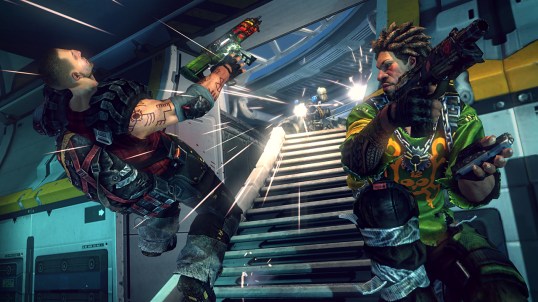As 2010 winds down to a close, this game critic’s finding himself for all FPS’ed out. True, the genre gave us the year’s biggest-selling games in Halo: Reach and Call of Duty: Black Ops. But, it’d be hard to argue that either game gives players an entirely new experience. As I wrote earlier, Brink seems poised to do that in a few ways. Splash Damage–the U.K.-based team making the game–hails from the world of competitive gaming and modding. I poke with various team members about their backgrounds and what’s going in to making one of 2011’s most intriguing games.
How did Splash Damage form as a studio?
Paul Wedgwood: We started out as Splash Damage back in the summer of 2001. Prior to that for a couple of years, a few of us here had worked together as a mod team using id Software as technology. We knew we loved multiplayer games, which was a super -niche thing back then. But we really had this strong belief that social interaction was the future of interactive entertainment. When our first big game Wolfenstein: Enemy Territory came out, it did really well.
Then, we started work on Enemy Territory: Quake Wars, which ended up being a pretty long production, about four years. But that was at a pace that id Software liked to work at. They liked to have smaller teams working on things for a long period of time and really iterate on ideas and polish elements of the game. At one point we cut 12 maps and started again about 18 months into development. It was a different approach to development but it taught us a kind of preparedness to kind of cut things that didn’t work and that led up to the end of 2007. We released that game and it did really well, too. But at this time it was in a declining PC market. Even though that was also a critical success, it came out the same week as Halo 3, Call of Duty: Modern Warfare on the console, Guitar Hero, the week after that. So we could see that if we wanted to continue doing what we did–which was core multiplayer experiences–we would have to make this transition to console development as well. It was the only thing we would be able to do. But, if we wanted to compete in that space, we knew we had create something that was completely new. (More on Techland: On the Brink: Hands-On with 2011’s Experimental Shooter)
So, what were the core ideas of that something new?
Wedgwood: Strangers should be able to play online and coordinate together and have fun and have it not be a game that makes you feel like you’ve been abused when you finish. If you’re talking to others using VOIP, you could be hearing racist insults, people telling you your girlfriend weighs 400 pounds or telling you how much suck five times in a row.
That isn’t what our game is about. Brink is about that kind of buzz, that satisfaction that comes from co-ordinated team play. How do you bring that to the newbie masses? Answering that question is kind of the goal of Brink. And that’s what happened. It was almost magical.
What has been the challenge in trying to create a single-player campaign and incentivize players to work cooperatively?
Richard Hamm, Creative Director: Well that’s probably the core central challenge from a design point of view of the entire game. Because we do want Brink to be almost be sort of a gateway drug. To get offline players interested in online play. We really just have to look at what kind of barriers to people face right now when they try to go online. Going into levels and playing against players who know the map like the back of their hand is a real problem. And so you’re really at a disadvantage. So what do we do? We integrate a system where you can, at a glance, look at this objective wheel, see everything that you can possibly do in a given mission, choose one, and then there are systems within the game that will help you find your way there no matter what.
Do you think that the multiplayer culture has become so inbred that it’s not newbie-friendly anymore?
Wedgwood: It never was newbie-friendly. If anything, it was exactly the same thing. There’s no difference between the elitist online shooter culture in late ‘97 when I was playing Quake 1 and the one that exists now in Halo. (More on Techland: Game System of the Future?: First Impressions of the OnLive MicroConsole)
Hamm: Yeah. You’d run into the same people 10 years ago. Their logic says: “I earned my stripes. I went through hell. They beat the crap out of me and I’m going to do it to you now.” It’s just as bad now.
How does Brink try to change that?
Wedgwood: Richard’s helped a lot in that regard. With his help, we’ve come upon mission system that’s entirely dynamic. The idea behind it is really straightforward. The game knows what combat role you’re playing, where you are on the battlefield, the status of all of the objectives and what your teammates are doing.
Hamm: It knows what the enemy is doing, too. And with all of that, the game suggests
the best thing you can do right now to help your team.



